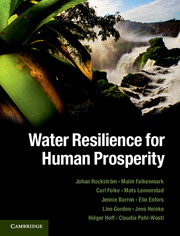Book contents
- Frontmatter
- Contents
- List of Contributors
- Preface
- Introduction to the book
- Acknowledgements
- Part I A new perspective
- Part II Living in a human-dominated world
- Part III Food production globally: in hotspot regions and in the landscape
- 5 Food production: a mega water challenge
- 6 Closing the yield gap in the savannah zone
- 7 Water resources and functions for agro-ecological systems at the landscape scale
- Part IV Governance and pathways
- Glossary
- Index
- References
6 - Closing the yield gap in the savannah zone
from Part III - Food production globally: in hotspot regions and in the landscape
Published online by Cambridge University Press: 05 August 2014
- Frontmatter
- Contents
- List of Contributors
- Preface
- Introduction to the book
- Acknowledgements
- Part I A new perspective
- Part II Living in a human-dominated world
- Part III Food production globally: in hotspot regions and in the landscape
- 5 Food production: a mega water challenge
- 6 Closing the yield gap in the savannah zone
- 7 Water resources and functions for agro-ecological systems at the landscape scale
- Part IV Governance and pathways
- Glossary
- Index
- References
Summary
This chapter takes a closer look at low-income countries in the savannah zone, where poverty and malnutrition are dominant features. Although high rainfall variability across time and space is a key challenge, this zone has substantial hydrological potential. The chapter analyses how investments in agricultural water management can contribute to closing the yield gap between actual and potential yields in the savannahs, and thereby to building resilience in these regions. The chapter discusses the range of technological, biophysical and social constraints currently limiting the uptake of these promising technologies. Conclusions are finally drawn regarding broad based farming system solutions that target the interacting constraints, and deal with the uncertainty of the future.
Challenges and opportunities in the savannah zone
This chapter examines the savannah zone, which presents an enormous development challenge but also a unique opportunity to improve food production and build social–ecological resilience. A major constraint on agro-ecological productivity across the world’s savannah regions is temporal shortages of water in the crop root zone. This chapter focuses on a set of small-scale practices that improve water management in agriculture to help overcome this constraint. If properly implemented and supported, these practices can unlock the agricultural potential of the savannah zone and provide a window of opportunity for improved livelihoods for millions of smallholder farmers across the world.
- Type
- Chapter
- Information
- Water Resilience for Human Prosperity , pp. 172 - 193Publisher: Cambridge University PressPrint publication year: 2014



